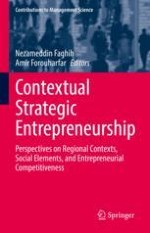2022 | OriginalPaper | Chapter
The Meaning of Being a Migrant Entrepreneur: An Intersectional Approach to Mixed Embeddedness Theory
Authors : Alexandra Heis, Petra Dannecker
Published in: Contextual Strategic Entrepreneurship
Publisher: Springer International Publishing
Activate our intelligent search to find suitable subject content or patents.
Select sections of text to find matching patents with Artificial Intelligence. powered by
Select sections of text to find additional relevant content using AI-assisted search. powered by
